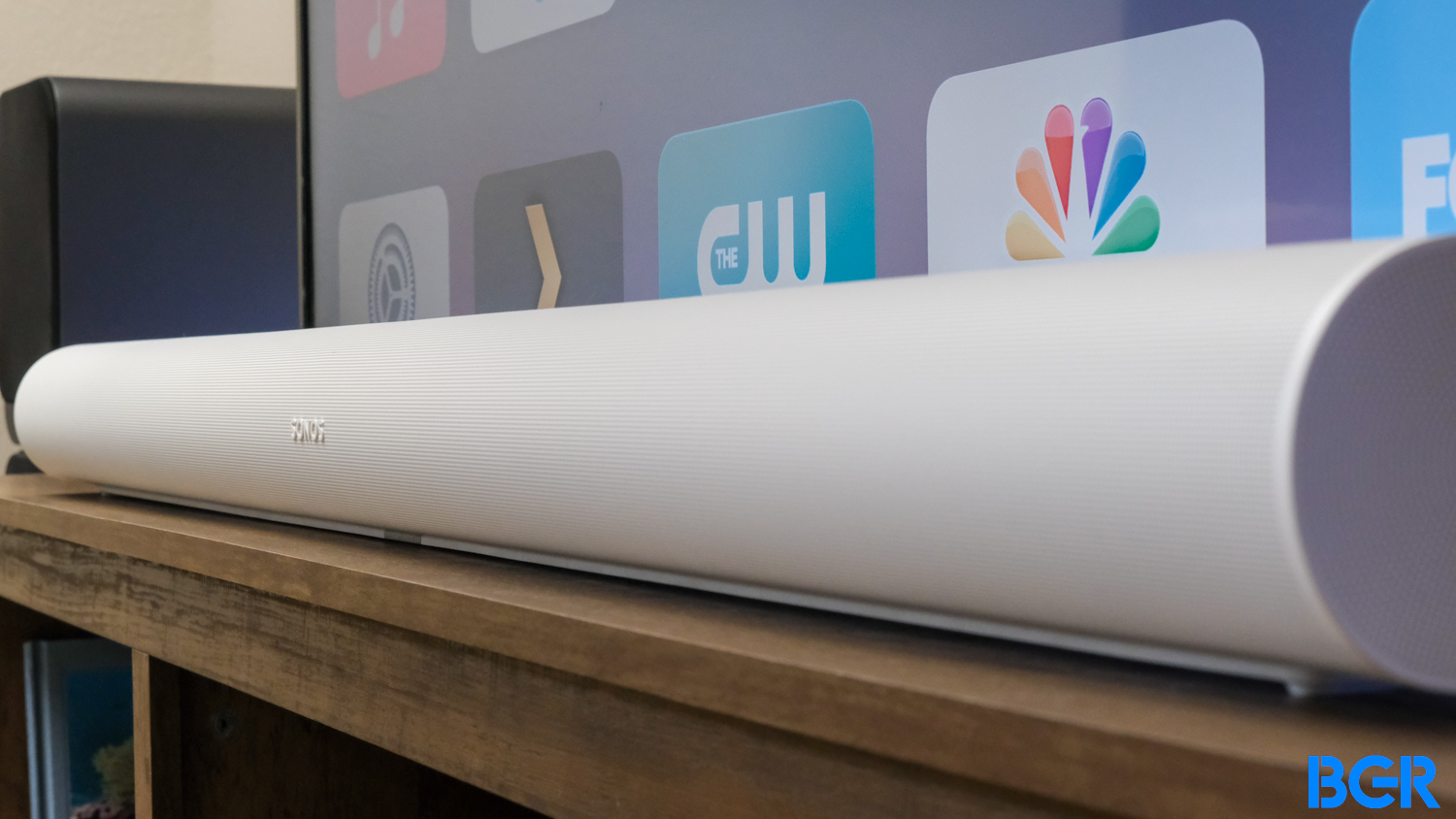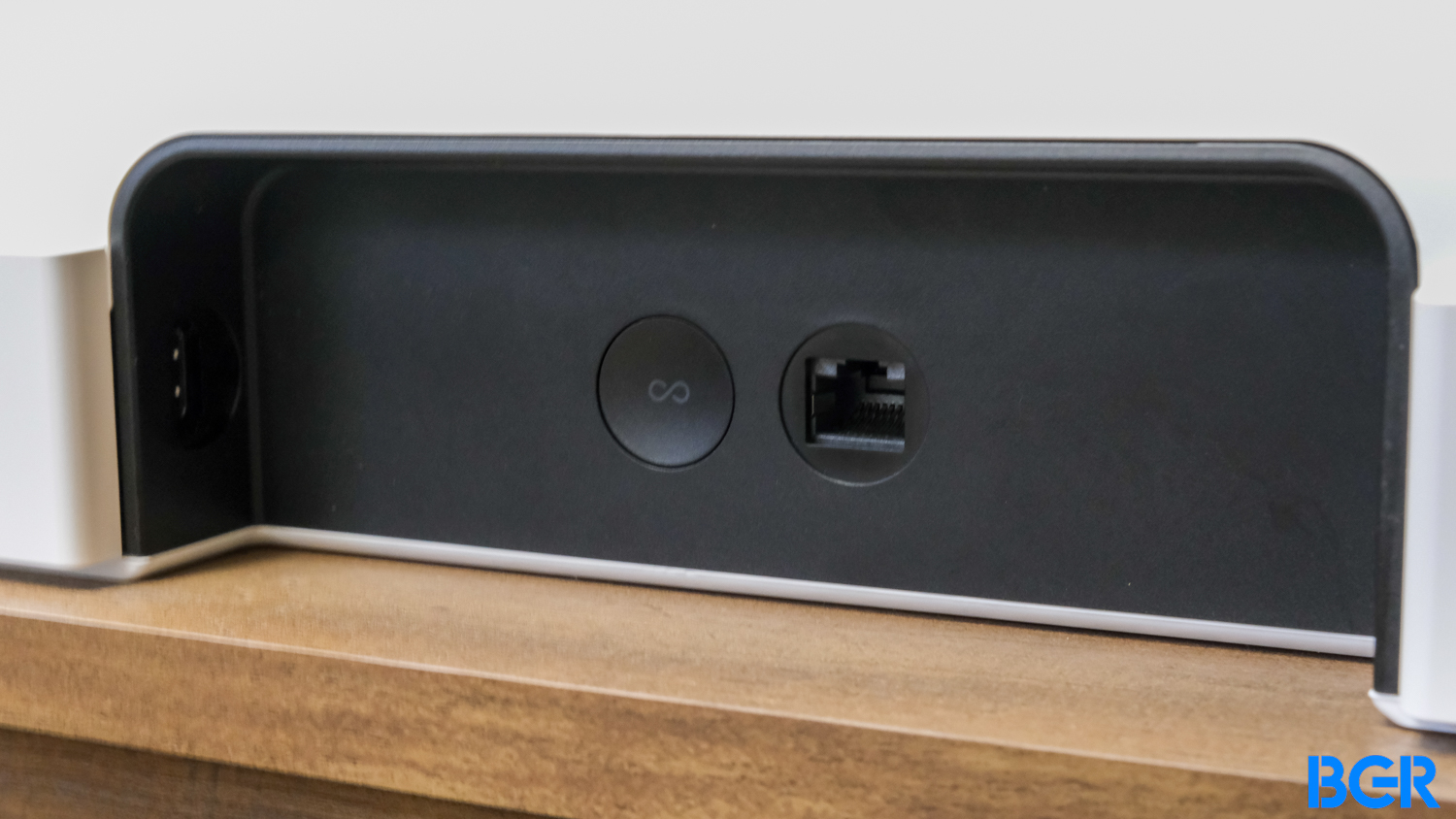Sonos Arc
The Sonos Arc is Sonos’ highest-end soundbar, and while it’s a little more expensive than Sonos’ other options, it’s worth the cash.
Pros
- Premium design
- Excellent sound
- Immersive audio
- Super smart features
Cons
- No HDMI passthrough
Sonos is no stranger to high-quality audio. Ever since its first speakers, the company has been known as a great option for those who want solid audio quality at an affordable price. That can be seen in its latest soundbar, the Sonos Ray, which is priced at $279. But what if you have more money to spend and want a higher-quality experience? Sonos has something for you too — in the form of the Sonos Arc.
This is its highest-end soundbar, above both the Sonos Ray and Sonos Beam. It’s not cheap, at $899 for the soundbar alone, and you’ll have to pay extra if you want the deeper bass on offer by the company’s subwoofer.
Does the Sonos Arc do enough to warrant its higher price? Or should you stick with the cheaper Sonos Beam or Sonos Ray? How’s the Dolby Atmos support? BGR has been using multiple Sonos Arc’s for years, and here’s our full review.
Sonos Arc design
The first thing to notice about the Sonos Arc, especially when compared to its other soundbars, is how wide it is. That helps play into its sound quality, of course, but it does mean you’ll have to find a good spot to place it on your TV stand or entertainment center. The soundbar is 45 inches wide, which isn’t small by any means. Many will be able to place the soundbar in front of their TV, but if you do, make sure you don’t cover up things like IR receivers if you need them. It sits in at 3.4 inches tall, which is a little taller than many other models, but still an acceptable height.

The soundbar is available in black and white, and we’re reviewing the white model. I prefer the black look, but I’m boring. Some might want something that stands out a little more, and to be fair, mounted on a wall the white probably blends in a little better.
On the back, the Arc is a little bare-bones — which will be fine for some, and not great for others. The soundbar basically just has a power input and an HDMI port that you’ll connect to your TV’s eARC port. You will get an optical to HDMI adapter to use with an optical port from TV. But, you won’t be able to use Dolby Atmos if you do so. There’s also an Ethernet port for better network connectivity.
Pretty much the entire front, top, and sides are covered with hole-punch speaker grilles. This is because of the fact that the soundbar is designed to simulate surround sound by bouncing audio off the walls and ceiling. It doesn’t look bad though, and in fact, everything is built from premium, high-end materials.
Setup
Setting up the Sonos Arc is relatively easy, and if you’ve set up a Sonos speaker in the past, you should have no issues setting up the Arc.
To set the Arc up, I started by connecting it to my TV and plugging it in. Then, I opened the Sonos app, and since I already had an account, I signed in. Under the Settings tab, I hit the Add New Product button, and then followed the on-screen instructions.

After basic setup, it’s worth setting up Trueplay. Sonos’ Trueplay basically tunes the speaker based on your room. The way sound interacts with its environment, like the room shape, your furniture, and so on, can change how it sounds quite a lot. Trueplay helps ensure that it’ll sound great regardless of your room. You can set up Trueplay through the Settings menu for the soundbar.
I did have a few issues with setting up the Arc with my account and existing Sonos speaker. These issues seemed to be related to needing to update the app and the other Sonos speaker in the house. Make sure everything is up to date before you start setting up the Arc.
Smart features
Of course, the design is one thing — but much more important are the features and sound quality on offer. Thankfully, the Sonos Arc seriously competes in both of those things.

Let’s start with the features on offer here, and there are a number to go through. For starters, the soundbar supports Apple’s AirPlay 2, meaning that you can access it from your default audio apps on your iPhone, and use it for multi-room audio. As someone with a few Sonos speakers, and a few HomePods around the house, it’s super nice to be able to play to all of them, instead of having to stick with one brand. Unfortunately, the Arc doesn’t support Google Cast. So you won’t get the same experience out of Apple’s ecosystem unless you go with an all-Sonos setup and use the Sonos app to play music.
But you’re not completely out of luck if you’re a Google user. Like other Sonos speakers, the Arc supports Google Assistant and Amazon Alexa. That means that you can use your preferred digital Assistant (except for Siri) to control your smart home devices, control your music, and get information from the web.
Of course, there are also the audio-related features — but we’ll get into those in the next section.
Sonos Arc sound
The Sonos Arc is Sonos’ highest-end, and as such, you would expect it to sound great. Thankfully, it does. The Sonos Arc outperforms every soundbar I’ve tried to date, and I love how the sound fills the space you’re listening in.
I tested the Sonos Arc by itself. That’s to say, I didn’t use it with any Sonos subwoofer, nor did I use it with surround speakers. Even without a subwoofer, the Arc was able to deliver deep and impactful bass response, ensuring that things like explosions sound nice and big. It offers the kind of bass you can hear — but not the kind you can feel. For that, you will need a sub, but don’t think that you won’t get a good experience without a sub. It’s just that you’ll get a better one with a sub.
The mids on the soundbar are well-tuned and decently accurate. And, the highs make for a detailed and clear experience. This is perhaps the main thing that I noticed moving from the Beam to the Arc.
Surround sound
One of the best things about the Arc is that it supports a range of modern audio formats, and is able to reproduce them with speakers that face up and to the sides. The device supports Dolby Atmos, TrueHD, Dolby Digital Plus, and Dolby Digital. You’ll need to have a TV compatible with these formats to take advantage of them.
The soundbar is able to deliver a decently immersive experience. Part of that is owed to the fact that the soundbar is so wide, but Sonos has done a great job at creating a technology that makes it sound like there’s actually audio coming from multiple sides. If you didn’t know that the Arc was actually bouncing audio off the ceiling and walls, you might actually believe that there were more speakers there.
Now, that’s not to discount the role of actual surround speakers — and if you have the space and money, pairing the Arc with a few Sonos One speakers for surround sound is definitely worth it. The Arc gets as close as it can to true immersion with Dolby Atmos, but if you truly want the full experience, you’ll need a subwoofer and some dedicated surround speakers.
Conclusions
It’s a home run for Sonos. It’s more expensive than its other offerings, to be sure, but if you can afford it, it’s worth the cash. The soundbar is detailed and immersive, and while a sub can help, alone the Arc still delivers deep and powerful sound.
So much so, that the Arc is perfect for audiophiles or home theater enthusiasts who don’t have the space or the money for an actual surround sound system. You’ll need to make sure that you have a TV that supports the modern audio standards, but if you do, you’ll love what the Arc has to offer.
The competition
The Sonos Arc isn’t the only high-end soundbar out there, but after reviewing it, I’m convinced that it’s the best soundbar at $900 or less, and better than many soundbars more expensive than that. If you don’t have a system that supports Dolby Atmos and other modern audio standards, then it may be worth going for the Sonos Beam instead of the Arc. But regardless, whether you’re already in Sonos’ ecosystem or not, the Arc is well worth considering.
Yes. It’s the best soundbar to beat under $1,000 right now.
If you can afford to buy the Sonos Arc, it’s worth upgrading to it over the Sonos Beam. The Sonos Beam is an excellent soundbar, but it’s not quite as impressive as the higher-end (and larger) Sonos Arc.
Yes. The Sonos Arc is excellent for movies, thanks to its deep bass and support for immersive standards like Dolby Atmos.
You can play Dolby Atmos content on the Sonos Arc, but it is emulated Atmos. It doesn’t have all of the speakers in a full home theater set up, though it is more than passable for movies, including dialogue, sound effects, and more. It also supports traditional surround sound.
Yes. You can hardwire the Sonos Arc to ethernet to connect to your network. This is an advanced installation method because it could affect how easy it is to connect the Sonos Sub, stream from Apple AirPlay and other wireless features with the soundbar.








